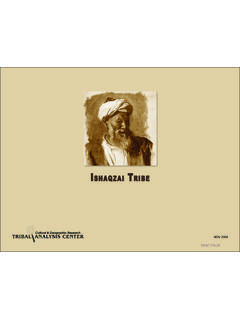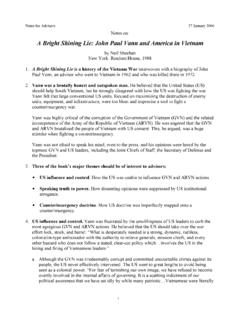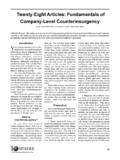Transcription of COUNTERINSURGENCY GENERal MEaSURES Of …
1 COUNTERINSURGENCY . G ener a l M e a sures o f E f f ecti v eness Cultural & Geographic Research TRIBAL ANALYSIS CENTER October 2009. COUNTERINSURGENCY GENERal MEaSURES of effectiveness COUNTERINSURGENCY . G ener a l M e a sures o f E f f ecti v eness C o p y r i g h t 2 0 0 9 Tr i b a l A n a l y s i s C e n t e r, LT D. All Rights Reserved Cultural & Geographic Research TRIBAL ANALYSIS CENTER. About Tribal Analysis Center Tribal Analysis Center, 6610-M Mooretown Road, Box 159. Williamsburg, VA, 23188. COUNTERINSURGENCY GENERal MEaSURES of effectiveness COUNTERINSURGENCY . GENERal MEaSURES of effectiveness Now, here, you see, it takes all the running you can do, to keep in the same place. If you want to get somewhere else, you must run at least twice as fast as that! [The Queen]. It was much pleasanter at home, when one wasn't always growing larger and smaller, and being ordered about by mice and rabbits.
2 [Alice]. Excerpt from Alice in Wonderland Lewis Carroll The concept of relative power provides a way to use the characteristics of insurgency as MEaSURES of effectiveness to help evaluate the performance and progress of both the insurgent and counterinsurgent. At its basic level, an insurgency is simply political violence, not unlike Clausewitz's often misquoted dictum, War is a continuation of policy by other means. But insurgencies are generally fought with tactics that are far below the levels of violence studied by strategists looking at conflict between states. Traditional combatants oppose their enemies through an increasingly violent series of tactics that can range from street demonstrations, robberies and kidnappings, terrorism, and guerrilla operations into forms of conventional warfare where armed insurgent elements are sufficiently powerful to attack government forces openly.
3 The upper levels of political violence are not generally available to insurgents, especially in the early stages of an insurgency, who are restricted to the tactics found in the lower levels: terrorism and guerrilla operations. Within these forms of conflict between the antagonists there runs a common but often misunderstood factor: relative power. At its foundation, this simple concept is just the difference in the power available to the political group controlling a national entity, such as a nation-state, and the power available to the political opposition that seeks to displace them. Additionally, this power relationship is reversible and normally varies greatly between rural and urban settings within the same insurgency. This power balance is responsible for the variety of tactics available to the insurgent. For example, there was a tremendous difference in the power available to the Symbionese Liberation Army (SLA) in San Francisco and the United States Government it sought eventually to overthrow.
4 The factor that separated their compared strength is Tribal Analysis Center, 6610-M Mooretown Road, Box 159. Williamsburg, VA, 23188. COUNTERINSURGENCY GENERal MEaSURES of effectiveness best seen as relative power and when compared to the power available to the entire nation-state, the strength available to the SLA. was insignificant to the point of non-existence, but the SLA survived for nearly two years as an insurgency within the United States. Another example occurred prior to World War II in China in which communist insurgents were able to survive the nearly overwhelming power available to the Nationalist Chinese government. After enduring defeat after defeat, the communists retreated far into China's interior and continued an insurgency. Soon after the end of World War II, the communist insurgency was able to defeat its more powerful enemy as the relative power shifted in their favor because of a variety of factors.
5 In the case of Russia, an extended period was required to go from initial insurgency development until the power relationship ultimately shifted in the insurgent's favor. From the defeated Decembrist Revolt in 1825 until the overthrow of the Czar's government, there was almost a century of nearly continuous anarchist activity a low level insurgency before the collapse of the Czar's government and an eventual insurgent victory. And in the end, the victorious insurgents were not identical to the original group that initiated the rebellion, but that early revolt produced the continuing grievance which sustained the various insurgents against their powerful opponent until the power relationship gradually shifted in their favor. At the least common denominator level, however, the relative power relationship between insurgents and the Czar's government was completely reversed during the century of unrest.
6 Any discussion of relative power requires an understanding of what is meant by the use of the term, power. In a traditional Western context, power is generally defined in terms of military capability and the capacity to sustain it. In the case of insurgency, the old Soviet analytical approach with its use of correlation of forces is probably more appropriate and nearly every conceivable factor that has a positive or negative impact on the power relationship between the two adversaries becomes significant. These factors may range from one side possessing a trusted, charismatic leader to having access to sympathetic international news media and all the factors in between the two. Insurgency analysis is much like passing through Lewis Carroll's looking glass when compared to traditional military analysis, but every conceivable factor becomes significant when trying to understand this sort of conflict.
7 In this strange, often upside down, world the insurgent intentionally kills innocent civilians, murders prisoners (while making a video of the event), but often fails to be condemned for the terror tactics. The generally more powerful security forces are routinely condemned by the same media sources that avoid criticism of the insurgents if innocent civilians are killed accidentally and prisoners are physically mistreated during interrogations. Under these realities, even the harsh word interrogation, is forbidden and must be substituted by interview. But every conceivable factor related to the power relationship between the insurgent and the entity the insurgents seek to replace is important. The efforts of both sides involve gaining control of as many of these interrelated factors as possible as they seek power at the expense of their opponent. Given the overwhelming power held by the challenged government during an insurgency's initiation, their security services generally will hold the initiative and develops its own strategy regardless of the early activities of the insurgents.
8 Frequently, a misguided strategy develops into efforts to dominate the population, particularly in rural areas, as this is the most common source of Tribal Analysis Center, 6610-M Mooretown Road, Box 159. Williamsburg, VA, 23188. COUNTERINSURGENCY GENERal MEaSURES of effectiveness support for the insurgents. Insurgent operations also develop within urban areas, but there are significant differences between the two, especially in the tactics that can be employed in urban areas where the government is much more powerful than the insurgent. The rural insurgent is able to disperse forces widely, making discovery of training areas and supply caches far more difficult. Security forces in rural areas are caught in a dilemma and must defend every conceivable target the insurgents may choose to attack. The insurgent, having access to a potentially large auxiliary, or part-time, force, is able to concentrate forces at the least defended location.
9 Having the advantage of initiative, the insurgent can use both terrorist and guerrilla tactics against the government's widely dispersed security forces. In this case, the relative power balance favors the insurgent who is able to develop the guerrilla's hit and run tactics against the defenders. Inside urban areas, the insurgent normally faces overwhelming government force, frequent penetration of both the auxiliary and operational cells by government agents, and seldom has the ability to concentrate its available force in full raids and ambush operations as are seen in the countryside. Here, the government's security forces are able to guard potential targets far better than in the rural areas and the relative power balance between the two so greatly favors the government that the insurgent must rely upon terrorist tactics, usually conducted by one or two operatives. Specific tactics are bombings, assassinations, and kidnappings that are low risk, but with high impact on the GENERal population that sees itself at great risk of becoming a victim of similar attacks.
10 Finally, urban areas may be relatively secure and terrorist tactics become difficult to utilize under conditions favorable to the government. If the relative power balance has shifted in the government's favor, the rural insurgents may be less capable of launching guerrilla operations in the countryside. In cases such as these, two phenomena are likely to occur. First, the insurgent is forced by the power available to the government to shift to terrorist tactics, shedding the unusable guerrilla warfare tactics and shifting to bombings, assassinations, and kidnappings. Under these conditions, this failing insurgency shifts a large amount of its effort into propaganda as it attempts to rebuild its support, particularly within the rural population. Second, sensing a lack of forthcoming support from the population, the floundering insurgency often begins to attack their former supporters in an effort to force them to return to their previous orientation toward the insurgents.









